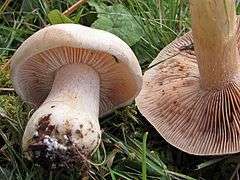Hebeloma
| Hebeloma | |
|---|---|
 | |
| H. crustuliniforme | |
| Scientific classification | |
| Kingdom: | Fungi |
| Division: | Basidiomycota |
| Class: | Agaricomycetes |
| Order: | Agaricales |
| Family: | Hymenogastraceae |
| Genus: | Hebeloma (Fr.) P.Kumm. (1871) |
| Type species | |
| Hebeloma fastibile (Pers.) P.Kumm. (1871) | |
Hebeloma is a genus of fungi in the family Hymenogastraceae.[1] Found worldwide, it contains the poison pie or fairy cakes (Hebeloma crustuliniforme) and the ghoul fungus (H. aminophilum), from Western Australia, which grows on rotting animal remains.
Etymology
The generic name is a compound Ancient Greek word of Hebe, "youth," or "puberty," and the suffix -loma, a fringe (pertaining to the fungal veil). Thus, Hebeloma translates as "youthful fringe/veil," in reference to how the fungal veil is only seen in immature specimens.[2]
See also
References
- ↑ Matheny PB, Curtis JM, Hofstetter V, Aime MC, Moncalvo JM, Ge ZW, Slot JC, Ammirati JF, Baroni TJ, Bougher NL, Hughes KW, Lodge DJ, Kerrigan RW, Seidl MT, Aanen DK, DeNitis M, Daniele GM, Desjardin DE, Kropp BR, Norvell LL, Parker A, Vellinga EC, Vilgalys R, Hibbett DS (2006). "Major clades of Agaricales: a multilocus phylogenetic overview" (PDF). Mycologia. 98 (6): 982–95. doi:10.3852/mycologia.98.6.982. PMID 17486974.
- ↑ Herefordshire Fungus Survey Group, News Sheet No 12: Autumn 2006
External links
- The veiled species of Hebeloma in the western United States by Alexander H. Smith, Vera Stucky Evenson, and Duane H. Mitchel, 1983. (Full text of monograph.)
This article is issued from Wikipedia - version of the 5/31/2016. The text is available under the Creative Commons Attribution/Share Alike but additional terms may apply for the media files.
